#hail the Ásynjur
Text
Female figures of norse mythology, by artist Thorskegga on DeviantArt



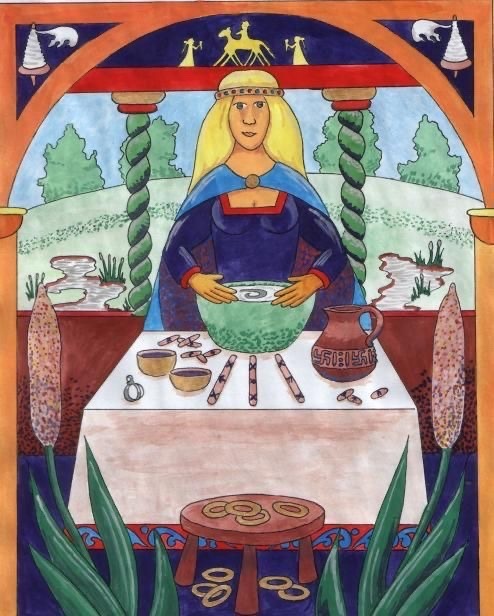

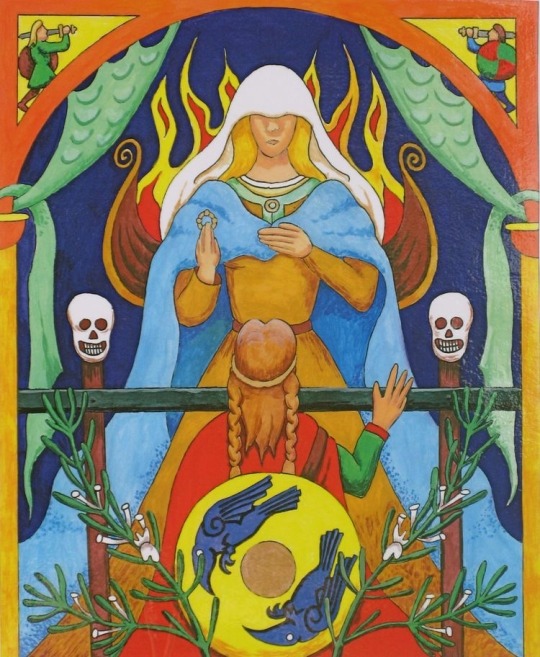

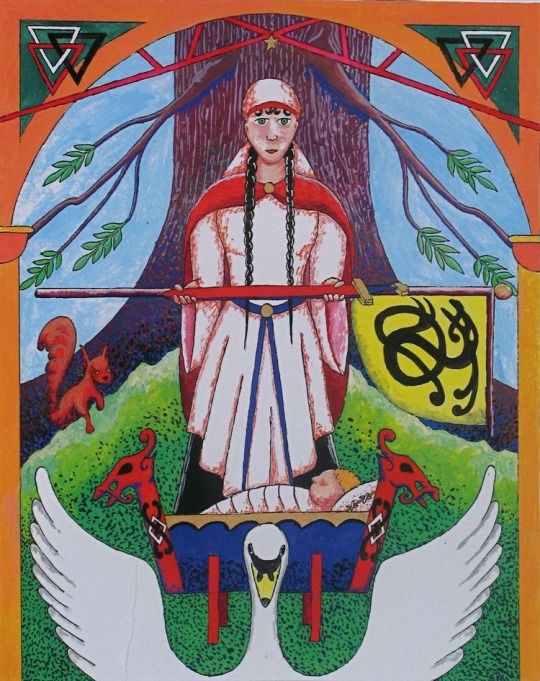
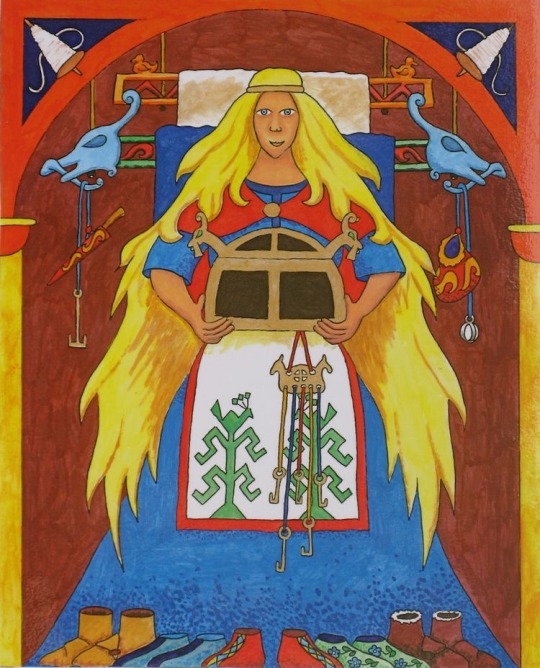
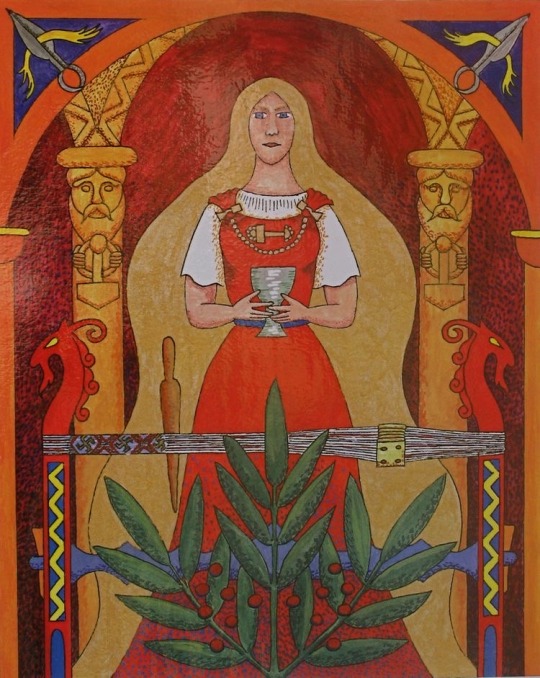
(Nerthus, Gerðr, Snotra, Saga, Sigyn, Nanna, Skuld, Verðandi, Fulla and Sif)
#they are beautiful!#art#hail the Ásynjur#hail the Valkyrjur#hail the handmaidens of Frigg#hail the Nornir#norse paganism#heathenry#norse gods#deities#deity work#spirituality#polytheism#paganism#norse polytheism
116 notes
·
View notes
Note
How is Jord viewed by modern Heathens? And how was she viewed by Heathens in pre-Christian Scandinavia and Iceland?
You probably did not expect my response to require a trigger warning but at the end of this post, behind a break, I’m going to talk about the intersection of domination of nature and the sexual domination of women by men in dróttkvætt poetry. All the straight-up non tw'd lore I'll keep before the break although it's a bit long. [edit] I guess tumblr doesn't do breaks anymore on the dashboard(?) so nevermind unless you're reading on my blog.
I'm actually preparing to write something about Jǫrð, after which I'll be better prepared to answer, but regardless there is a seeming contradiction when approaching Jǫrð: there’s a great deal of research to be done, and you always come up feeling like you’ve got very little. It’s like there is very little substantial lore, but it’s spread thin throughout the entire body of literature. One of the reasons for this is that the way that Jǫrð -- the goddess and person with parents and children -- is not differentiated from the actual physical dirt we stand on. The names Hlóðyn (or Hlǫðyn) and Fjǫrgyn are more likely to be used when describing her as a personality, but there are very many synonyms for earth and they can all be used for Jǫrð (fold, frón, grund, hauðr láð, land, storð, etc) and in poetic language the whole earth can be invoked with reference just to specific land formations, like mountains or hills. Interestingly, there isn’t really a clear distinction between Ymir’s flesh and Thor’s mother. Nordic poetry encourages these kinds of semantic slippages, so I don’t feel completely confident saying that it’s how everyone thought of these things, but there is really nothing to suggest that there is an “Earth goddess” separate from all the other aspects of the ground or planet.
Since I’m writing in English, when I say “she” it seems like I’m emphasizing personhood, but Old Norse does not make this distinction; inanimate objects can be “he” or “she” and animate ones can be “it.” So though Old Norse always uses the pronoun equivalent to “she” for Jǫrð, this is a baked-in aspect of the word being grammatically feminine, and not an assertion of her personhood.
She does appear in the famous prayer in Sigrdrífumál, referred to as fold, a synonym for earth:
Heilir æsir,
heilar ásynjur,
heil sjá in fjǫlnýta fold.
'Hail the Æsir,
hail the Ásynjur,
hail the bountiful earth.'
She isn’t mentioned very frequently in mythology “proper” except in relation to Thor. In Hárbarðljóð the ferryman (Odin) tells Thor his mother is dead to which Thor remarks that many people would find it quite remarkable if that were true (some translations of hverjum þykkir mest give the impression that Thor’s saying people would think it were good if his mother were dead, but I’m not reading it that way... I’m open to being told I’m translating incorrectly though)
Her father is Ánarr or Ónarr. Snorri says she’s a daughter of Odin, but as John McKinnell pointed out, this is probably a mistake. In some manuscripts the name Ánarr is written “annarr,” which means ‘second’; since þriði “third” is a name of Odin, it was probably assumed that “second” also was. Ánarr/Ónarr is a dwarf name, so Jǫrð is perhaps the daughter of a dwarf. How she is both someone’s daughter and the dismembered flesh of Ymir is not something I can answer. Her brother is Dellingr, father of Dagr (Day), and she has a half-brother, Auðr. Her mother is Nátt (Night) although there is some confusion in some manuscripts about this, and it isn’t backed up by skaldic poetry (though it isn’t denied either)
There was a goddess recognized in Roman-occupied Germania in the first few centuries, AD, called Hludana in Latinized Germanic. This name may be related to Jǫrð’s byname Hlóðyn. There are other theories about its meaning as well, so this remains speculative, but it is very possible.
Some scholars speculate that the reason Jǫrð isn’t emphasized more as a goddess is because there are other goddesses who play overlapping roles, such as perhaps Gerðr (and/or Sif?); or because Jǫrð was a goddess of very broad and general relevance and that Nordic people were more likely to recognize very localized beings instead, like perhaps Þorgerðr Hǫlgabrúðr. We might even try to speculate that Hlóðyn and Fjǫrgyn could be names of region-specific goddesses of the land, which became synonymous with the more general Jǫrð through poetic equivalences like those I mentioned earlier.
Now, there’s an important aspect that I’ve left out so far but should be discussed. Heathens don’t like to talk about it (or, generally, know about it), but we have a responsibility to be able to discuss and process it. In skaldic poetry, a king conquering territory is sometimes referred to metaphorically as that king seducing or forcing himself on a personified Jǫrð. This is discussed in Meeting the Other in Norse Myth and Legend by John McKinnell, pp. 154-5. This is depicted most clearly in Hákonardrápa, a praise poem for a heathen king of Norway who was also an actual literal mass rapist. Many feminist, decolonial, and ecological thinkers (I think most famously, but far from exclusively, Murray Bookchin and Abdullah Öcalan; see also the article by Vanessa Watts which is also included in the link I'll put at the end) have proposed that in the western world, men’s domination of land and non-human nature is conceptually linked to men’s domination of women; in Norse history and poetry this is made explicit. Jǫrð, who is both a woman and land, is overspecified as a target of violence in the thought-world of late Norse court poetry, and unfortunately that is the context from which we get the most evidence for Old Norse religion. I expect that if we had lore from other contexts, it would be quite different. I also believe that this relationship to the land is part of why we don't see more overt veneration of Jǫrð in the sources.
For what it’s worth, I don’t believe this was inevitable, and it definitely isn’t a fixed or essential part of Nordic paganism, but we should confront it rather than dismiss it, especially while modern heathens continue to dupe themselves into believing the problem with medieval Scandinavian rulers was that they were Christian, not that they were rulers. I need to research this more before I can comment on it confidently, but as far as I know, it’s believed that Scandinavian people held land in common in the distant past, and legally-enforced private ownership of land came later. It was probably unthinkable within Scandinavia itself, but during the Age of Migrations, war leaders would reward their followers by doling out conquered territory, giving the best tracts of land to the highest-ranking soldiers. This was probably the inception of private land ownership for Germanic language-speaking people; óðal was originally land taken from defeated enemies; óðal is violence. How it traveled back north to Scandinavia, I’m not exactly sure, but once it was conceivable elsewhere it was possible to recreate back up north.
The only reasonable conclusion for modern heathens is that developing a relationship with Jǫrð means accounting for the historical catastrophe of dividing the earth into privately-owned parcels and taking up the responsibility of repairing those relations with her, and the human relations that are contingent on that domination of the earth, not just by saying “Hail Jǫrð” at sumbl and repeating affirmations that we are grateful to her, but by addressing the fact that our entire modern capitalist system is built on her denigration and dispossession, that the entire western concept of the “human” is defined by domination of the planet (hence, places where Indigenous people were considered by European settlers not to be maximizing the productive output of the earth through agriculture was considered “empty” and up for grabs by settlers). Being recon means that when the product of reconstruction is historical failure, I have to take up the responsibility that my ancestors aren't around to shoulder.
The modern heathen who, to my knowledge, has done the most visible work toward rebuilding a relationship with Jǫrð and recognizing the responsibility that that entails is @falkabarn who hosts a ritual for Jǫrð every year and is currently working on compiling and editing a devotional (which, based on the timing of this ask, I suspect might have motivated it). I’m also aware that in Denmark, there has been some intersection of Nordic animism and direct action like tree sits, though I don’t know details about how they articulate their position. There is likely more that I don’t know about.

(from the Tornsangerland Bli'r tree sit).
For a very small selection of alternative ways of relating to the land, see the "Week 1" section of the following reading list: https://yellowheadinstitute.org/an-indigenous-abolitionist-study-guide/
110 notes
·
View notes
Text
The prayer of the Valkyrja in Sigrdrífumál - translated in Dutch
Hēla*, Dag!
Hēla, zonen van de Dag!
Hēla, Nacht, en haar dochter!
Aanschouw ons (beiden) met milde ogen
en gun de aanwezigen de eindzege!
Hēla, Goden!
Hēla, Godinnen!
Hēla, welwillende Aarde!
Gun ons zeggingskracht en wijsheid
en helende handen, zolang wij leven!
This is my, Dutch, translation of stanza 3 and 4 in Sigrdrífumál.
3.
"Heill dagr!
Heilir dags synir!
Heil nótt ok nipt!
Óreiðum augum lítið okkr þinig
ok gefið sitjöndum sigr!
4.
Heilir æsir!
Heilar ásynjur!
Heil sjá in fjölnýta fold!
Mál ok mannvit gefið okkr mærum tveim
ok læknishendr, meðan lifum."
Henry Adams Bellows, in 1936, translated it like this:
Hail, day!
Hail, sons of day!
And night and her daughter now!
Look on us here with loving eyes,
That waiting we victory win.
Hail to the gods!
Ye goddesses, hail,
And all the generous earth!
Give to us wisdom and goodly speech,
And healing hands, life-long.
Edward Pettit, 2023:
Hail, Dagr!
Hail, Dagr’s sons!
Hail, Nótt and her kinswoman!
Look upon us both here with unwrathful eyes,
and give victory to those sitting [here]!
Hail, Æsir!
Hail, Ásynjur!
Hail, the multiply-helpful earth!
Give eloquence and commonsense to us two glorious ones,
and healing hands as long as we live!
Benjamin Thorpe, in 1865:
Hail Dag,
Hail Dag's sons,
Hail Nat and Nipt!
Look down upon us
With benevolent eyes
And give victory to the sitting!
Hail Asas,
Hail Asynjes,
Hail bounteous earth!
Words and wisdom
give to us noble twain,
and healing hands in life!
Or by Jackson Crawford, 2015:
Hail the day!
Hail the sons of day!
Hail to night and her sister!
Look on the two of us here with friendly eyes
and give us victory!
Hail the gods!
Hail the goddesses!
Hail the hospitable earth!
Give the two of us eloquent speech, and wisdom
and healing hands, while we live.
youtube
*I have chosen the old Dutch word Hēla over He.l because of the pollution of that word. Hēla can be dated to the 10th century, which connects us with the time the poems in the Edda's are written. However, in Dutch, the word He.l is still in use, in f.e. "he.lzaam" or "ik zie er geen he.l in". It is a Dutch word, there is no rational reason not to use it, only an emotional one. 'Leve', 'Voorspoed', 'Welzijn' or 'Geluk' are suitable alternatives.
#Sigrdrífumál#old norse#ritual#viking age#dutch#valkyrja#oudnederlands#my research#prayer#poetic edda#codex regius
0 notes
Text
3.8K written today -- writing the back half of this chapter and then I’ll go back and finish the first half so I can stop getting distracted and trying to do sequel set-up on autopilot. (I swear to god that I actually am doing it on autopilot, it’s how my brain works. It’s also very inconvenient because people get real mad at you when you don’t actually write a sequel. Yes, of course I’m talking about Gambit.)
Snippet from On Yonder Hill 6.
The music cut off with a final flourish at another gesture; Loki waited until as many people as possible could crowd in from the courtyard before he poured the cups in front of him and Thor full. Then the two brothers rose to their feet, looking suddenly very alike despite the difference in coloring.
Thor lifted his cup, which was something very like cut-crystal in a sheath of golden metal with figured gripping animal designs. “I drink to our glorious dead!” he said. “They are feasting in Valhalla with all our kin back to the beginning of time. Remember us kindly until we come to dine with you again, for even the gods must die.” He and Loki both turned to salute the empty chairs on either side of them. “Hail to the Æsir!”
“Hail!”
“Hail to the Ásynjur!”
“Hail!”
This time Natasha heard the very slight vowel shift – the difference between the divine living Aesir and the deified dead Æsir and Ásynjur. She lifted her cup with the Asgardians and drank, but not much – she had the feeling that there was going to be a lot more drinking to go.
Loki lifted his cup. “I drink to our living!” he said. “I drink to those who passed through the great void of Ginnungagap and returned to walk once more upon the branches of the World Tree. I drink to those who passed through the fires of Ragnarok to make new life and a new Asgard. Hail to the Aesir!”
“Hail!”
“Hail to the Asynjur!”
“Hail!”
#daily fic snippet#roleswap endgame au concept#religion worldbuilding...one of my favorite things to do#one of the first things I do when I'm worldbuilding cultures
16 notes
·
View notes
Video
youtube
Gealdýr - Loki
=======
At last, a piece of music for Loki!
=====
I, Lopt, from a journey long,
To ask of the gods,
that one should give Fair mead for a drink to me
x4 Loki son of Laufey, Loki
At your feast a place and a seat prepare me
Or bid me forth to fare.
x4 Loki son of Laufey, Loki
Hail the Gods, Hail the Goddesses
x4 Loki son of Laufey, Loki
x4 Loki son of Laufey,
Loki Loki son of Laufey, Loki
----
Lyrics (Old Norse)
Loftr, um langan veg ásu at biðja,
at mér einn gefi mæran drykk mjaðar.
x4 Loki laufeyjarson, Loki
Sessa ok staði velið mér sumbli at eða heitið mik heðan.
x4 Loki laufeyjarson, Loki
Heilir æsir,
heilar ásynjur
Loki laufeyjarson, Loki
x4 Loki laufeyjarson
20 notes
·
View notes
Text
Sigrdrifumal 2-3
Heill dagr,
heilir dags synir,
heil nótt ok nipt;
óreiðum augum
lítið okkr þinig
ok gefið sitjöndum sigr.
Heilir æsir,
heilar ásynjur,
heil sjá in fjölnýta fold,
mál ok mannvit
gefið okkr mærum tveim
ok læknishendr, meðan lifum!
-
Hail the Day - Hail sons of Day!
Hail Night and Nipt, Her daughter!
Look on us with loving eyes,
and grant us victory!
Hail the Gods and Goddess!
Hail the Earth who gives us life!
Give us noble words of wisdom
and healing hands in life!
2 notes
·
View notes
Photo

Las "pequeñas" cosas de la vida que me emocionan. Encender el fuego diario a los dioses y ver que la pequeña manzana que mi hija le ofrendo a #Iðunn sigue incorrupta, quizás un poco arrugada, recordándonos que la hermosa #ásynjur esposa de #Bragi, en cuyo #eski guarda los tesoros que comparte solo con los dioses, también proyecta el rejuvenecimiento y la fertilidad hacia nosotros. ¡Delicada #dis que moras en los valles! ¡Hail! https://www.instagram.com/p/CAP360Wnbqh/?igshid=g1fdryffd8ue
1 note
·
View note
Text
Heilir Æsir, heilar Ásynjur ok öll ginnheilög goð!
Hail you, Asir, hail you, Asynjur and hail all most holy Gods!
I dedicate this little blog to you as a place of worship, contemplation and relentlessly mocking Nazis.
1 note
·
View note
Photo

So yet again sleep eludes me, nothing new lol. So naturally I went to the beach and suddenly sleep doesn't matter. The first thing the came to mind was sigfrieds prayer, Have you guys heard of it? It comes from the text knows as Sigrdrífumál, I'll give the original and the translation below (disclaimer: you'll find loads of different translations online, I Studied old Norse at Copenhagen uni and this is the translation I think is the best, just my personal opinion, don't kill me 😘): Heill dagr. Heilir dags synir. Heil nótt ok nift. Óreiðum augum lítið okkr þinig ok gefið sitjöndum sigr. Heilir æsir. Heilar ásynjur. Heil sjá in fjölnýta fold. Mál ok mannvit gefið okkr mærum tveim ok læknishendr, meðan lifum. Hail day Hail sons of the day Hail night and daughters Look at us two With eyes not angry And give us who sit here Triumph Hail Gods Hail Goddesses Hail this abundant earth Give words and wisdom To us two in our glory And hands of healing While we live
56 notes
·
View notes
Text
Get to know the norse Goddesses:
A quick run down!
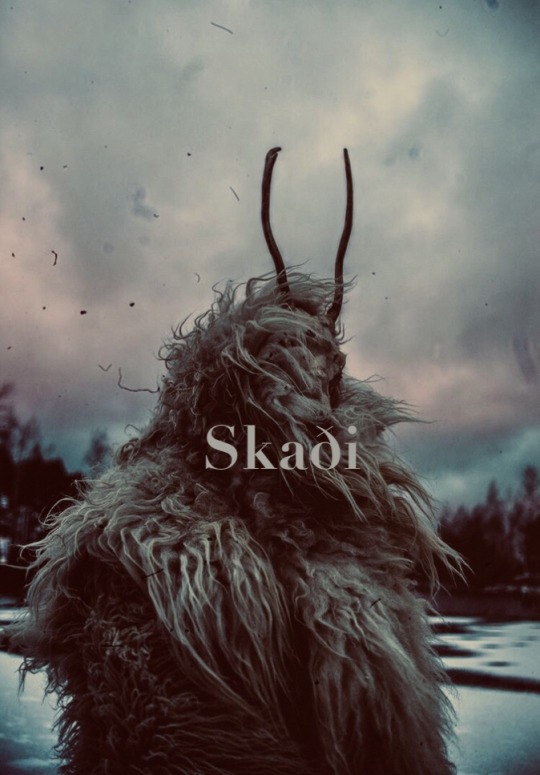

Skaði; the Avenger. Daughter of the giant Thiazi, a strong and fearless figure who didn’t hesitate to face the Gods looking for retribution after her father’s death. Associated with winter, hunting, snow and wolves.
Sif; the Golden-Haired. Fair wife of Thor, renowned among the Gods for her beautiful locks of golden hair. It is believed she was associated with harvest, fertility, and the hearth.
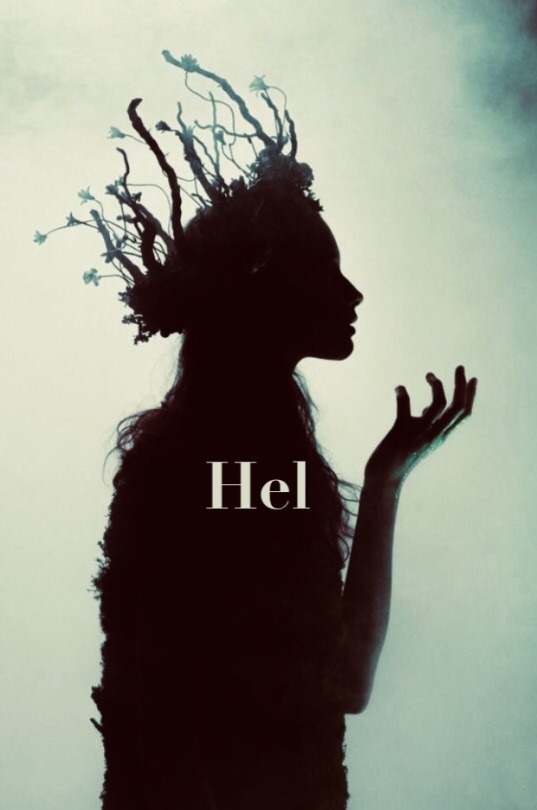
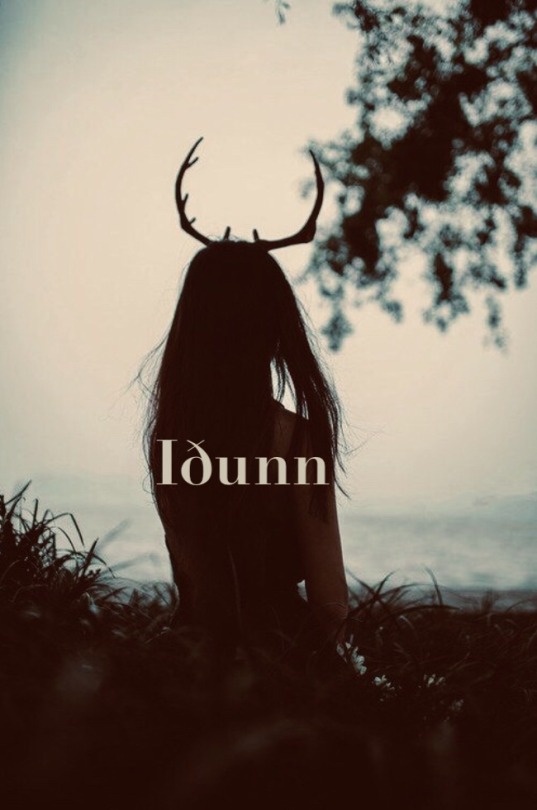
Hel; Queen of the Dead. Daughter of Loki, one half of her body decays like a corpse while the other is fresh and young. She reigns over Helheim, realm of the dead, with her hound Garm. Associated with death but most of all, the acceptance of it.
Iðunn; the Eternally Young. Fair, generous and luminous, keeper of the golden apples which grant the Gods their immortality. Associated with purity, youth and innocence.

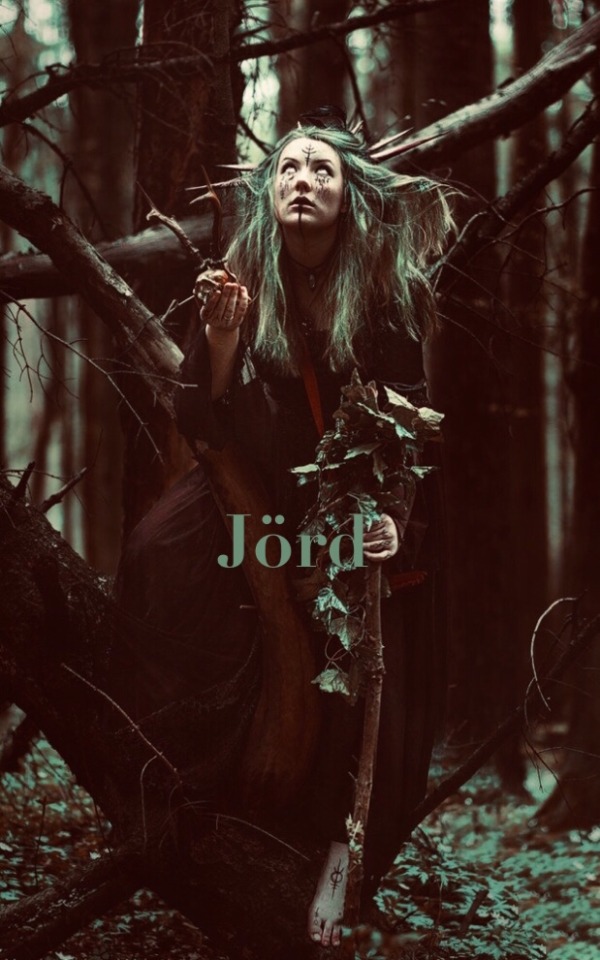
Frigg; the Prophetess. Wife of Odin and blessed with the gift of foresight, though she is said to keep all knowledge of the future to herself. Allmother associated with childbirth, motherhood and family matters as well as divination.
Jörð; the Fertile Earth. Giantess and mother of Thor, embodying the spirit of the earth. Associated with nature, wildlife and the prosperity of land.
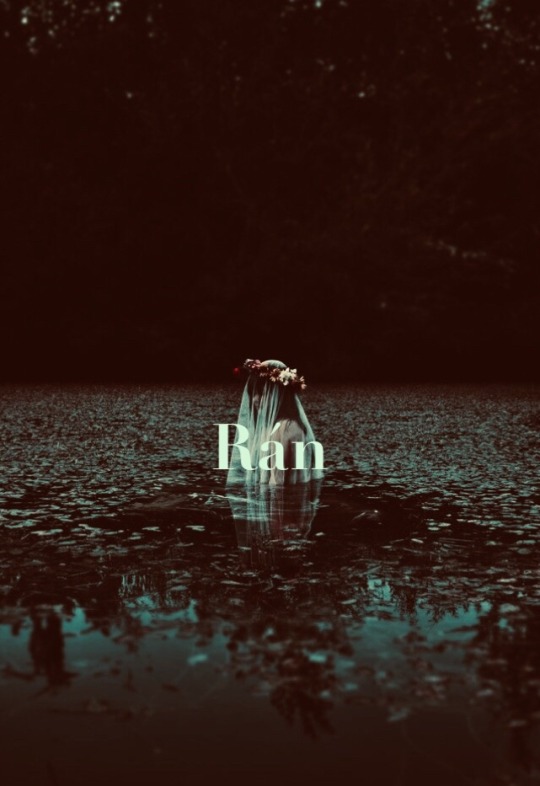
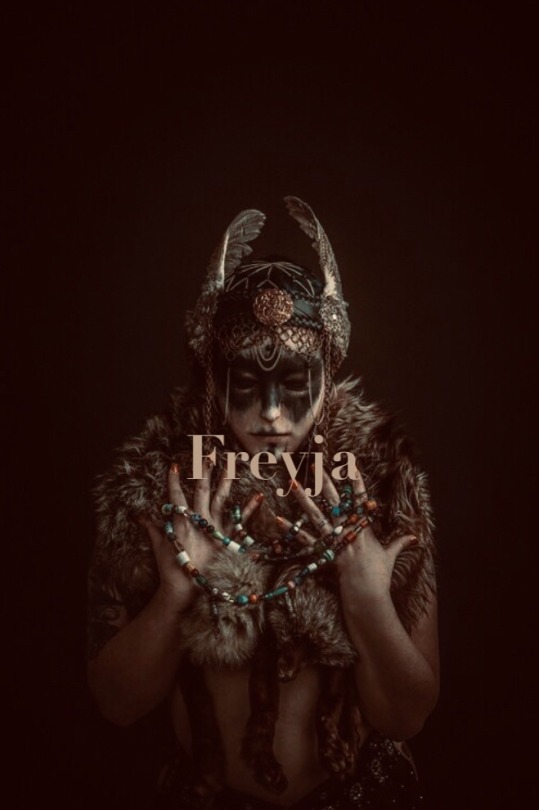
Rán; the Restless Sea. Embodying the dangers of voyage at sea, she was said to sink ships who ventured on her waters. She dwells in an underwater palace where she pulls her victims to stay with her for eternity. Associated with the ocean and death at sea.
Freyja; the Sorceress. Sister of Freyr, she masters the art of seidr (magic) and is known as the most beautiful of the Goddesses. Associated with love and sexuality, but also battle and death: along with Oðinn, she chooses the fallen warriors who will fight alongside the Gods during Ragnarök.
Hail the Vanir, hail the Ásynjur
#norse witchcraft#norse mythology#norse paganism#norse gods#freyja#witchy aesthetic#polytheism#heathenry#lokean#deities#deity work#aesthetic#spirituality#mythology#vikings
3K notes
·
View notes
Photo

Piadosa #Eir, #Ásynjur amiga de #Frigg, vigilante desde #Lyfjaberg, tranquila y calmada, que merced de los #Vanir conoces hierbas y pociones, te pedimos poses tu suave mirada sobre nosotros en estos momentos de dolor e incertidumbre cuando la peste se ensaña sobre nosotros ¡Que tu suave mano de sanadora acaricie frentes afiebradas y tu aliento traiga salud y resurrección! ¡Paz y calma para aquellos que sufren porque tu alivias los males y angustias de la enfermedad! ¡Hail Vair! ¡Hail Aesir! imagen: #Menglöð y las nueve doncellas en Lyfjaberg (1893) by Lorenz #Frølich. https://www.instagram.com/p/B9yD3uBJFFB/?igshid=dibc4i3oa3yb
0 notes